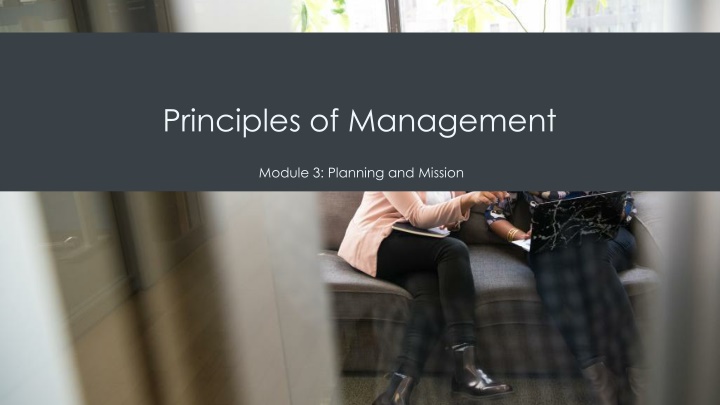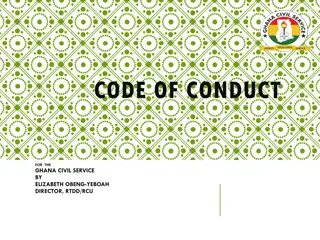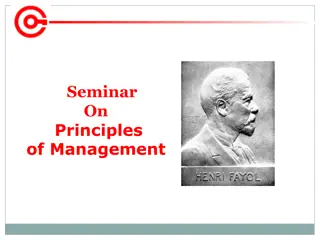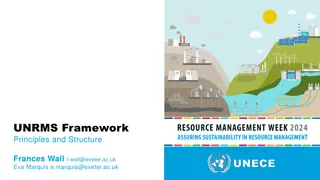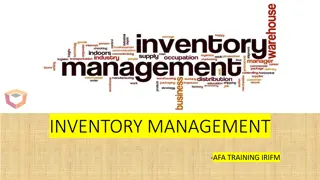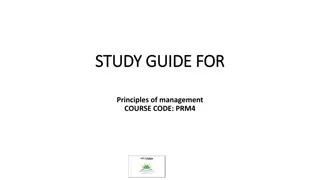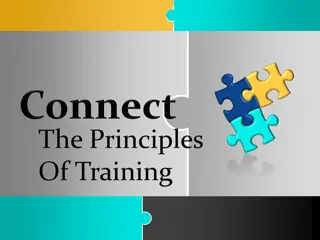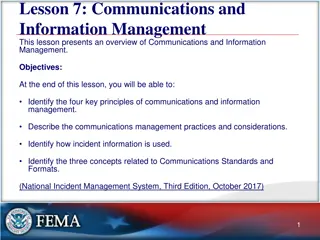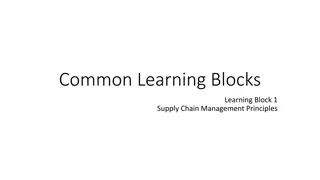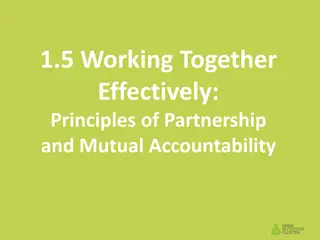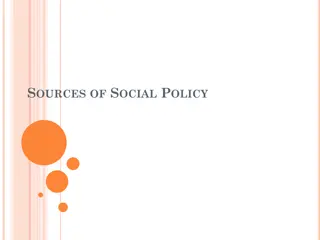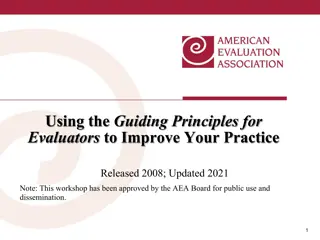Principles of Management
This module delves into the importance of aligning planning processes with an organization's mission, vision, and values. It covers distinguishing between mission, vision, and values, exploring the pros and cons of planning, explaining the stages of the planning cycle, and describing various types of plans and planning tools. Additionally, it discusses the significance of mission statements, vision statements, and values statements in guiding organizational strategy and behavior.
Download Presentation

Please find below an Image/Link to download the presentation.
The content on the website is provided AS IS for your information and personal use only. It may not be sold, licensed, or shared on other websites without obtaining consent from the author.If you encounter any issues during the download, it is possible that the publisher has removed the file from their server.
You are allowed to download the files provided on this website for personal or commercial use, subject to the condition that they are used lawfully. All files are the property of their respective owners.
The content on the website is provided AS IS for your information and personal use only. It may not be sold, licensed, or shared on other websites without obtaining consent from the author.
E N D
Presentation Transcript
Principles of Management Module 3: Planning and Mission
Module Learning Outcomes Explain how managers align the planning process with company mission, vision, and values 3.1: Distinguish between mission, vision, and values 3.2: Explain the pros and cons of planning 3.3: Explain the stages of the planning cycle 3.4: List and describe the types of plans and common planning tools
Learning Outcomes: Mission, Vision, and Values 3.1: Distinguish between mission, vision, and values 3.1.1: Distinguish between mission and vision in business 3.1.2: Explain how a values statement can support the goals of an organization
Understanding Mission Mission Statement describes what organization needs to do to achieve vision will be more specific than vision statement conveys to stakeholders why the organization exists explains how it creates value for the market or the larger community
Understanding Vision Vision Statement is a statement of organization s overarching aspirations of what it hopes to achieve should inspire people motivate people to want to be part of and contribute to the organization. should be clear and concise, usually not longer than a short paragraph
Understanding Values Values Statement defines what organization believes in describes how people should behave must be reinforced at all levels of organization called the code of ethics provides a standard for employees to judge violations.
Practice Question 1 In his groundbreaking book, The Lean Startup , Eric Ries discusses the concept of true north as it relates to planning. The true north concept is an attempt to define an organization s ultimate destination. True north would be an example of which of these: - - - Mission Vision Values
Class Activity: Mission, Vision, and Values Compare and contrast the definitions of mission, vision, and values statements. List similarities and differences of the three statements. In addition, find examples from the same industry, such as sports clothing, music, or another type product, using the definitions in the text. What do the businesses have in common with their statements? How do they differ?
Learning Outcomes: Pros and Cons of Planning 3.2: Explain the pros and cons of planning 3.2.1: Explain benefits of planning 3.2.2: Explain the drawbacks of planning
Understanding Pros and Cons of Planning Pros of Planning Provides a guide for action Improves resource utilization Provides motivation and commitment Sets performance standards Allows flexibility Cons of Planning Prevents action Leads to complacency Prevents flexibility Inhibits creativity
Class Discussion: Planning If having a good plan can lead managers to believe they know where the organization is going and how it will get there, then how may this mindset cause them to fail to monitor the progress of the plan or to detect changes in the environment?
Learning Outcomes: The Planning Cycle 3.3: Explain the stages of the planning cycle 3.3.1: Explain the stages of the planning cycle 3.3.2: Explain why the planning cycle is an essential part of running a business
Six Stages of the Planning Cycle Define objectives Develop premises Evaluate alternatives Identify resources Plan and implement tasks Determine tracking and evaluation methods
Essential Aspects of the Planning Cycle Maintaining organizational focus Defining specific goals to consider the vision, mission, and values of the organization Encouraging diverse participation Provides opportunity for input Establish planning committees that intentionally include people from diverse backgrounds Empowering and motivating employees Empowers people to contribute Motivates them to support outcomes
Class Activity: What is an Iterative Process? Organizations have goals they want to achieve, so they must consider the best way of reaching their goals and must decide the specific steps to be taken. However, this is not a linear, step-by-step process. It is an iterative process with each step reconsidered as more information is gathered. As organizations go through the planning, they may realize that a different approach is better and go back to start again. What does the phrase iterative process mean? In your own words, explain how this phrase connects to the six stages of the planning cycle.
Learning Outcomes: Types of Plans and Common Planning Tools 3.4: List and describe the types of plans and common planning tools 3.4.1: Differentiate between the uses of long-term plans, short-term plans, and operational plans 3.4.2: Differentiate between standing plans and single-use plans 3.4.3: Explain how policies, procedures, and regulations impact operational plans 3.4.4: Explain the role budgets in the planning process 3.4.5: Differentiate between forecasting, scenario planning, and contingency planning 3.4.6: Explain the use of "management by objectives" (MBO), SMART goals, and benchmarking in planning
Types of Plans Long term Crucial to ultimate success Top management responsible for these plans Short term Allocate resources for a year or less must be monitored and updated Standing Plans Policies, procedures, and regulations Single-use One-time project or event (budgets, project schedules)
Policies, Procedures, and Regulations Policies: broad guidelines for smooth operation- hiring and firing, promotions, etc. Procedures: steps to be followed in established operations- reflect company policies and support long- term goals Regulations: what is allowed and what is strictly prohibited= state and federal governments issue regulations often
Long-term and short-term goals Watch the short animated video for a brief overview of the importance of long-term and short-term planning. Long Term and Short Term Planning Animated
Role of Budgets in Planning Process Single-use and short-term Different budget types Financial: balance sheets/expense statements Operating: project revenue against expenditures Nonmonetary: allocate resources such as labor and workspace Fixed: do not change: sales revenue Flexible: vary with level of activity
Role of Budgets in Planning Process (cont) Important planning tool: going over budget is sign of poor planning. In some cases, to routinely come in under budget is also viewed negatively, because with more accurate budgeting those committed resources could have been allocated to other projects. Often, projects compete for limited resources so the best budget is the one that most closely projects actual expenses and revenue.
Forecasting, Scenario Planning, and Contingency Planning Forecasting Makes a prediction about future Scientific forecasting is using mathematical models, historical data, and statistical analysis Long-range forecasting requires both quantitative numerical data and qualitative data based on experts Contingency plans Describes what will happen in a possible but not expected--situation Used to handle emergency situations
Management By Objective and SMART Goals Management By Objective (MBO) Jointly set goals and objectives, plan tasks for employees, agree on standards for evaluating performance, meet to review progress often SMART Goals Provides incentives to employees, empowering them to set own objectives, honestly communication with workers Specific, Measurable, Achievable, Relevant, Time-bound Benchmarking: looing for performance levels outside organization Industry, geography, organization, processes, innovation
Benchmarking looks for performance levels outside your organization, and sometimes across departments Industry Geography Consider the regional economy Organization Consider the economic climate Processes May also be called strategic benchmarking Innovation Considers processes used by partners or competitors consider your competitors
Practice Question 2 Which of these benchmarking metrics would be most valuable to an organization: Your competitors can produce their competing products for 25% less than your manufacturing costs. Public corporations in your state are seeing growth rates of 15% year over year. Analysts are forecasting a 10% degradation of consumer purchasing next year. A review of annual reports reveals that the market leader has added a CRO (Chief Revenue Officer) to their stable of executives. Industry consultants brief you that two new startups have entered the market and have streamlined their testing processes to half the normal time required.
Quick Review Distinguish between a mission, a vision, and values Explain the benefits and drawbacks of planning Explain the stages of the planning cycle List and describe the types of plans and common planning tools Define MBOs, SMART GOALs, and Benchmarking
